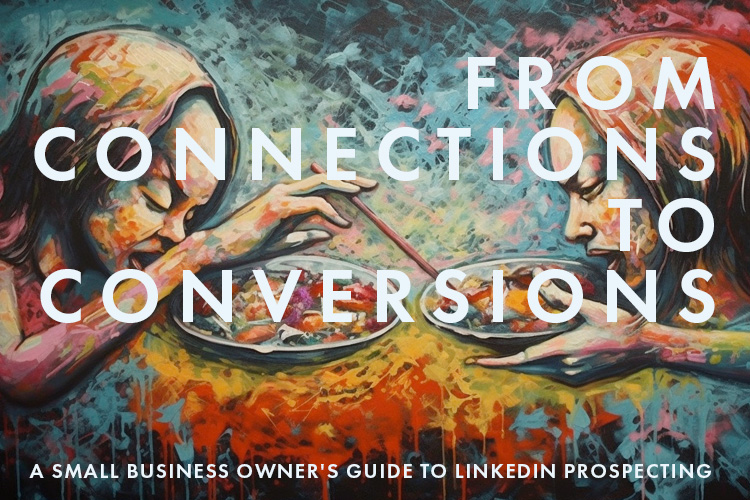Importance of LinkedIn for small businesses
LinkedIn has become a vital platform for small businesses looking to expand their reach and connect with potential customers. With over 740 million members worldwide (LinkedIn Facts and Statistics 2022 Edition), LinkedIn provides a unique opportunity to build relationships, showcase your brand, and ultimately, drive sales. However, many small business owners struggle with how to effectively prospect on LinkedIn and turn connections into conversions.
In this article, we’ll provide a comprehensive guide on how to successfully capitalize on your prospecting efforts on LinkedIn. From building a strong profile to defining your target audience, approaching prospects, nurturing relationships, and utilizing tools like LinkedIn Sales Navigator, we’ll cover everything you need to know to maximize your LinkedIn prospecting strategies and drive business growth.

Building a Strong LinkedIn Profile
Your LinkedIn profile is essentially your digital business card, and it’s the first thing potential customers will see when they search for your business on LinkedIn. Here’s how to make sure your profile is optimized for prospecting:
- Crafting a Compelling Profile Headline and Summary: Your profile headline should be a concise, attention-grabbing statement that communicates who you are and what you do. Your summary should provide more detail on your background, skills, and accomplishments, and include relevant keywords to help you appear in LinkedIn searches.
- Highlighting Key Skills and Experiences: Make sure to include your most important skills and experiences in your profile, focusing on those that are most relevant to your target audience. Use concrete examples and metrics to demonstrate your value proposition and differentiate yourself from competitors.
- Showcasing Your Brand Through Multimedia Content: LinkedIn allows you to add multimedia content, such as videos, images, and presentations, to your profile. Use these tools to showcase your brand and provide additional context on your products and services.
By taking the time to optimize your LinkedIn profile, you’ll make it easier for potential customers to find and connect with you, and increase your chances of converting connections into customers.
Defining Your Target Audience
To effectively prospect on LinkedIn, it’s important to define your target audience and tailor your messaging to their specific needs and interests. Here’s how to get started:
- Identifying Your Ideal Customer Persona: Start by creating a detailed profile of your ideal customer, including their demographics, job title, industry, pain points, and interests. Use this persona to guide your messaging and outreach efforts.
- Using LinkedIn’s Search Filters to Find Potential Leads: LinkedIn offers a wide range of search filters that allow you to narrow down potential leads based on criteria such as location, industry, job title, and company size. Use these filters to identify relevant prospects and start building your network.
- Analyzing LinkedIn Data to Refine Your Prospecting Efforts: LinkedIn also provides valuable data on your network and prospects, including their activity, interests, and engagement with your content. Use this data to refine your prospecting efforts and tailor your messaging to specific segments of your audience.
By defining your target audience and leveraging LinkedIn’s search and data analytics tools, you’ll be able to identify the right prospects and engage with them in a more meaningful way, increasing your chances of converting them into customers.
Approaching Prospects on LinkedIn
Approaching prospects on LinkedIn can be tricky, as it’s important to strike a balance between being friendly and professional. Here’s how to do it effectively:
- Crafting Personalized Connection Requests: When sending connection requests, make sure to personalize your message and explain why you’re interested in connecting with that person. Mention any common interests or connections, and avoid using generic messages that sound spammy.
- Building Rapport Through Messaging and Engagement: Once you’ve connected with a prospect, start building rapport by engaging with their content and messaging them with personalized, value-driven messages. Avoid jumping straight into a sales pitch and focus on building a relationship first.
- Avoiding Common Pitfalls in LinkedIn Prospecting: Finally, be aware of common pitfalls in LinkedIn prospecting, such as being too pushy, using automation tools, or sending irrelevant messages. Always focus on providing value to your prospects and building a relationship based on trust and mutual benefit.
By approaching prospects in a personalized, value-driven way, you’ll be able to build meaningful relationships on LinkedIn and increase your chances of converting prospects into customers.
Nurturing Your LinkedIn Relationships
Nurturing your LinkedIn relationships is key to building a strong network and ultimately converting connections into customers. Here’s how to do it effectively:
- Sharing Valuable Content with Your Connections: LinkedIn is a content-driven platform, so make sure to share valuable and relevant content with your network on a regular basis. This can include articles, blog posts, infographics, videos, and more. By providing value to your connections, you’ll build trust and increase engagement.
- Building a Reputation as a Thought Leader in Your Industry: LinkedIn is also a great platform to establish yourself as a thought leader in your industry. Publish your own content, participate in discussions, and engage with others in your industry to build your reputation and establish credibility.
- Keeping Track of Your Interactions with Potential Leads: Finally, it’s important to keep track of your interactions with potential leads using LinkedIn’s built-in CRM tools or an external tool like HubSpot or Salesforce. This will help you stay organized and follow up with leads in a timely and relevant manner.
By nurturing your relationships on LinkedIn through valuable content, thought leadership, and effective relationship management, you’ll be able to build a strong network and increase your chances of converting connections into customers.
LinkedIn Sales Navigator
LinkedIn Sales Navigator is a powerful tool for small business owners looking to take their prospecting efforts to the next level. Here’s what you need to know:
- Overview of Sales Navigator as a Prospecting Tool: Sales Navigator is a premium subscription service offered by LinkedIn that provides advanced prospecting features and tools to help you find and connect with potential leads. It’s designed specifically for sales and marketing professionals looking to build a strong pipeline of leads and opportunities.
- Advanced Search Filters and Lead Recommendations: Sales Navigator offers advanced search filters that allow you to narrow down potential leads based on criteria such as job title, industry, company size, and more. It also provides lead recommendations based on your ideal customer persona and past interactions on LinkedIn.
- Using Sales Navigator to Identify Decision-Makers and Influencers: Sales Navigator is particularly useful for identifying decision-makers and influencers within target accounts. You can use its advanced search filters and lead recommendations to find the right people to reach out to and build relationships with.
- Integrating Sales Navigator with Your CRM for Seamless Lead Management: Finally, Sales Navigator can be integrated with your CRM (customer relationship management) software to create a seamless lead management process. This allows you to easily track and manage leads from LinkedIn within your existing sales and marketing workflow.
By using Sales Navigator as a prospecting tool, you’ll be able to identify the right prospects, build stronger relationships, and ultimately increase your chances of converting them into customers.
Converting LinkedIn Connections into Customers
Converting LinkedIn connections into customers is the ultimate goal of your prospecting efforts. Here are some tips to help you close the deal:
- Creating a Seamless Sales Funnel for LinkedIn Prospects: To convert your LinkedIn connections into customers, you need to create a seamless sales funnel that guides prospects through the buyer’s journey. This can include lead magnets, email campaigns, sales calls, and more. By providing a smooth and personalized experience, you’ll increase the likelihood of converting prospects into customers.
- Using LinkedIn’s Advertising Tools to Drive Conversions: LinkedIn offers a variety of advertising tools that can help you reach a larger audience and drive conversions. Sponsored content, sponsored InMail, and LinkedIn Ads can all be used to promote your brand, products, or services to potential leads on the platform.
- Measuring the ROI of Your LinkedIn Prospecting Efforts: Finally, it’s important to measure the ROI of your LinkedIn prospecting efforts to ensure that you’re getting a positive return on investment. This can include tracking metrics such as lead conversion rate, cost per lead, and revenue generated from LinkedIn leads.
By creating a seamless sales funnel, using LinkedIn’s advertising tools, and measuring the ROI of your efforts, you’ll be able to convert more LinkedIn connections into customers and grow your business.
Recap of Key Takeaways
LinkedIn is a powerful platform for small business owners looking to generate leads and grow their customer base. By crafting a strong profile, defining your target audience, approaching prospects in a personalized manner, nurturing your relationships, and leveraging tools such as Sales Navigator and LinkedIn’s advertising features, you can successfully capitalize on your prospecting efforts.
Remember to create a seamless sales funnel for your prospects, measure the ROI of your LinkedIn prospecting efforts, and continue to build your knowledge and skills through resources such as Sales Navigator training and support.
With these key takeaways in mind, we encourage you to put your newfound knowledge into practice and start seeing results from your LinkedIn prospecting efforts. Good luck!


